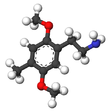2C-D

| |||
| |||
| Names | |||
|---|---|---|---|
| Preferred IUPAC name
2-(2,5-Dimethoxy-4-methylphenyl)ethan-1-amine | |||
Other names
| |||
| Identifiers | |||
CAS Number
|
|||
3D model (JSmol)
|
|||
| ChEMBL | |||
| ChemSpider | |||
PubChem CID
|
|||
| UNII | |||
CompTox Dashboard (EPA)
|
|||
show
InChI | |||
show
SMILES | |||
| Properties | |||
Chemical formula
|
C11H17NO2 | ||
| Molar mass | 195.262 g·mol−1 | ||
| Melting point | 213 to 214 °C (415 to 417 °F; 486 to 487 K) (hydrochloride) | ||
Except where otherwise noted, data are given for materials in their standard state (at 25 °C [77 °F], 100 kPa). | |||
| Infobox references | |||
2C-D (2,5-dimethoxy-4-methylphenethylamine or 2C-M) is a psychedelic drug of the 2C family that is sometimes used as an entheogen. It was first synthesized in 1970 by a team from the Texas Research Institute of Mental Sciences,[1] and its activity was subsequently investigated in humans by Alexander Shulgin. In his book PiHKAL, Shulgin lists the dosage range as being from 20 to 60 mg.[2]
Not much information is known about the toxicity of 2C-D, as no major studies have been conducted. According to Shulgin, the effects of 2C-D typically last for 4–6 hours.[2] Shulgin himself referred to this substance as a “pharmacological tofu,” meaning that when mixed with other substances, it can extend or potentiate their effects without coloring the experience too much, in a manner similar to how tofu absorbs the flavors of sauces or spices it is cooked with. Hanscarl Leuner, working in Germany, explored the use of 2C-D under the name LE-25 in psychotherapeutic research.[citation needed]
Drug prohibition laws[]
China[]
As of October 2015 2C-D is a controlled substance in China.[3]
Canada[]
As of October 31, 2016; 2C-D is a controlled substance (Schedule III) in Canada.[4]
Denmark[]
2C-D is added to the list of Schedule B controlled substances.[5]
Germany[]
2C-D is an Anlage I controlled drug.
Sweden[]
Sveriges riksdags health ministry classified 2C-D as "health hazard" under the act (Act on the Prohibition of Certain Goods Dangerous to Health) as of Mar 1, 2005, in their regulation SFS 2005:26 listed as "2,5-dimetoxi-4-metylfenetylamin (2C-D)", making it illegal to sell or possess.[6]
United States[]
2C-D became a Schedule I Controlled Substance in the United States as of July 9, 2012, with the signing of Food and Drug Administration Safety and Innovation Act.[7] On a state level, both Oklahoma and Pennsylvania list 2C-D under schedule I.
References[]
- ^ Ho BT, Tansey LW, Balster RL, An R, McIsaac WM, Harris RT (January 1970). "Amphetamine analogs. II. Methylated phenethylamines". Journal of Medicinal Chemistry. 13 (1): 134–5. doi:10.1021/jm00295a034. PMID 5412084.
- ^ Jump up to: a b 2C-D Entry in PiHKAL
- ^ "关于印发《非药用类麻醉药品和精神药品列管办法》的通知" (in Chinese). China Food and Drug Administration. 27 September 2015. Archived from the original on 1 October 2015. Retrieved 1 October 2015.
- ^ http://gazette.gc.ca/rp-pr/p2/2016/2016-05-04/html/sor-dors72-eng.php
- ^ https://www.retsinformation.dk/Forms/R0710.aspx?id=137169
- ^ http://www.notisum.se/rnp/sls/sfs/20050026.pdf
- ^ "S. 3187". Archived from the original on 2012-12-14. Retrieved 2012-07-11.
- 2C (psychedelics)
- Designer drugs

